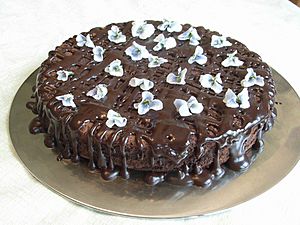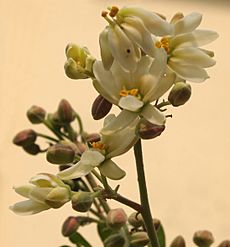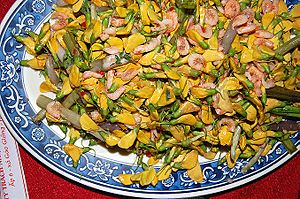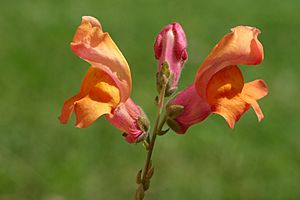Edible flower facts for kids

Edible flowers are flowers that you can safely eat. People use flowers in many ways. They can be a main part of a meal, like a vegetable, or they can be used like herbs to add flavor. You can find edible flowers in many types of cooking, including Asian, European, and Middle Eastern cuisines.
Why We Eat Flowers
Flowers have amazing and special flavors, textures, and colors. This makes them a popular and fun ingredient for chefs and home cooks. People add them to foods to give them flavor, a nice smell, and to make them look pretty.
You can eat flowers as part of a main dish or mix them into salads. They can also add flavor to beverages or be used to make drinks like tisanes (herbal teas) and wines. Some people even add flowers to spreads like butter or fruit preserves, or to vinegar, marinades, and dressings.
Some flowers are also eaten because they are good for you. For example, dandelion flowers have many healthy things like polyphenols and antioxidants. They can even help reduce inflammation in your body.
For the best taste, it's good to pick flowers when they are fresh, usually early in the morning. Flowers that look wilted or faded, or buds that haven't opened yet, might not taste as good and can sometimes be bitter. The taste and color of honey can change depending on which flowers the bees visited! Many flowers can be eaten whole, but some have bitter parts, like the stamens (the parts inside the flower that hold pollen) and stems, which you might want to remove.
Important Safety Tips
It's very important to know that not all flowers are safe to eat. Some flowers are only safe in small amounts. For example, apple flowers have tiny amounts of things that can turn into cyanide. Johnny jump-ups have something called saponins.
Other flowers can affect your body in different ways. Borage and daylily flowers can make you go to the bathroom more often, and sweet woodruff can make your blood thinner. Even linden tree flowers, which are generally safe in small amounts, can cause heart problems if you eat too many. Marigolds can also be harmful in large amounts, and only certain types taste good.
A big risk is that some toxic flowers look a lot like edible ones. Also, different plants might share the same common name, even if one is safe and the other is not. Always be 100% sure what flower you are eating!
Just like some foods, flowers can cause severe allergies in some people. If you have allergies, be extra careful. Also, flowers grown in gardens as ornamental plants (just for looks) are usually not meant to be eaten. They might have been sprayed with chemicals that are not safe for food.
Popular Edible Flowers

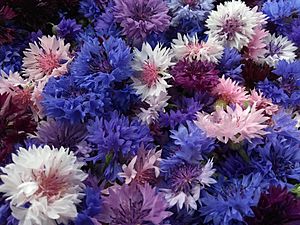
Did you know that some common foods are actually flowers or parts of flowers? For example, the expensive spice saffron comes from the stigmas and styles inside a type of crocus flower. Also, broccoli, artichokes, and capers are all flower buds that we eat before they fully open! Remember, even if a flower is edible, other parts of the plant might be poisonous.
Here are some flowers that are known to be safe to eat:
- American elderberry (Sambucus canadensis)
- Anise hyssop (Agastache foeniculum)
- Arugula (Eruca sativa)
- Banana blossom
- Basil (Ocimum basilicum)
- Bean (Phaseolus vulgaris)
- Bergamot (Monarda didyma)
- Black locust (only the flowers are edible). People use these flowers to make tea or add them to pancakes. In many parts of Europe, they are eaten as fritters (fried in batter).
- Broccoli (Brassica oleracea var. italica)
- Broussonetia kurzii
- Butterfly pea (Clitoria ternatea)
- Cauliflower (Brassica oleracea)
- Chamomile (Chamaemelum nobile)
- Chervil (Anthriscus cerefolium)
- Chinese hibiscus (Hibiscus rosa-sinensis)
- Chives (Allium schoenoprasum)
- Chicory (Cichorium intybus)
- Chickweed (Stellaria Media)
- Chrysanthemum (Chrysanthemum spp.)
- Cornflower (Centaurea cyanus)
- Cosmos (C. Sulphureus) (C. Bipinatus)
- Dandelion (Taraxacum officinale)
- Dianthus (Dianthus spp.)
- Dill (Anethum graveolens)
- English marigold (Calendula officinalis)
- English daisy (Bellis perennis)
- Fennel (Foeniculum vulgare)
- Geranium (Pelargonium spp.)
- Hollyhock (Alcea rosea)
- Japanese honeysuckle (Lonicera japonica) – but be careful, other types of honeysuckle are not safe, and their berries are very poisonous.
- Lavender (Lavandula spp.)
- Lilac (Syringa vulgaris)
- Lovage (Levisticum officinale)
- Maguey flower (Agave spp.)
- Mangrove trumpet tree (Dolichandrone spathacea)
- Markhamia stipulata, which looks similar to the Mangrove trumpet tree flower.
- Mint (Mentha spp.)
- Nasturtium (Tropaeolum majus)
- Okra (Abelmoschus esculentus)
- Passionflower (Passiflora spp.)
- Pineapple sage (Salvia elegans)
- Red clover (Trifolium pratense)
- Rose (Rosa spp.)
- Rosemary (Rosmarinus officinalis)
- Sage (Salvia officinalis)
- Sesbania grandiflora, a very popular edible flower in South Asia and Southeast Asia.
- Snapdragon (Antirrhinum majus)
- Squash (Cucurbita pepo)
- Sunflower (Helianthus annuus)
- Thyme (Thymus vulgaris)
- Violet (Viola odorata)
See also
 In Spanish: Flor comestible para niños
In Spanish: Flor comestible para niños


